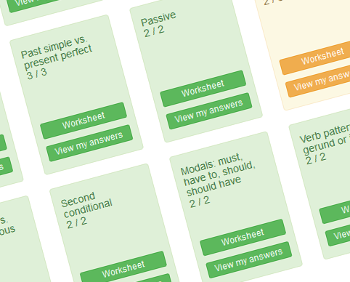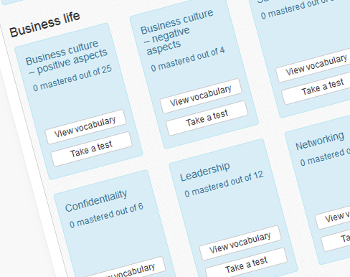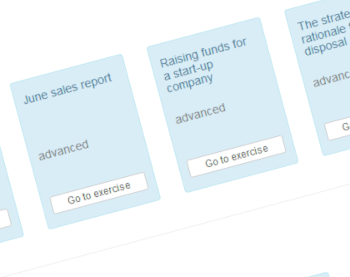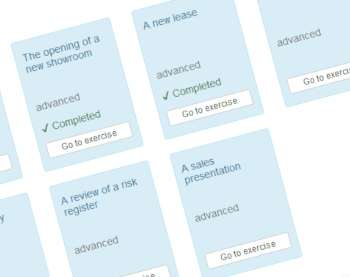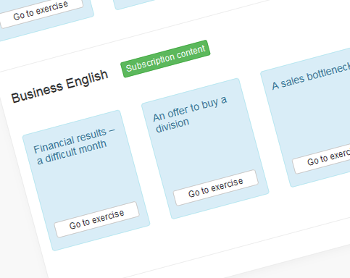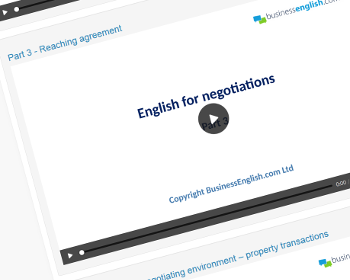Passato remoto progressivo
(Past continuous)
Introduzione
Il past continuous è usato per descrivere un'azione progressiva nel passato (l'azione inizia e finisce nel passato).L'azione può essere interrotta da un'azione più breve (past simple) o da un'ora specifica, per esempio:
-
I was preparing dinner when he arrived. past continuous past simple
-
At 8am yesterday I was working. specific
timepast continuous
-
While he was watching television, his sisters were doing their homework. past
continuouspast
continuous
Parte 1 - Past continuous positivo
Formiamo il past continuous conla forma passata del verbo "to be" ("was", "were")
+ la forma in "ing’" del verbo principale (present participle)
Per esempio:
-
I
He / She / Itwas playing football. You
We
Theywere
-
I
He / She / Itwas watching television. You
We
Theywere
-
I
He / She / Itwas reading a book. You
We
Theywere
Pratica
Completa le frasi con la forma corretta del past continuous positivo del verbo tra parentesi.
.Parte 2 - Past continuous negativo
Per formare una frase negativa usiamo "wasn't" ("was not") / "weren't" ("were not").Per esempio:
-
I
He / She / Itwasn't playing football. You
We
Theyweren't
-
I
He / She / Itwasn't watching television. You
We
Theyweren't
-
I
He / She / Itwasn't reading a book. You
We
Theyweren't
Pratica
Completa le frasi con la forma negativa corretta del past continuous del verbo tra parentesi.
.Parte 3 - Domande col past continuous
Per fare domande mettiamo "was" / "were" prima del soggettoPer esempio:
-
Was he playing football? Were you
-
Was she watching television? Were they
-
Was the dog running?
-
Were we being noisy?
Risposte brevi
| Yes, |
I
he / she / it |
was. |
| No, |
I
he / she / it |
wasn't. |
| Yes, |
you
we they |
were. |
| No, |
you
we they |
weren't. |
Pratica
Completa le frasi con la forma interrogativa corretta del past continuous del verbo tra parentesi.
.Ulteriore pratica
Scegli la risposta corretta per completare la frase: a, b, c o d..
Punto di lingua intermedio
Il past continuous è considerato un tempo narrativo e può essere usato per creare o descrivere un'atmosfera in un momento del passato o per una storia.Per esempio:
- When she arrived home, everyone was shouting, the baby was crying, the dogs were barking, and outside it was raining heavily.
Il past continuous può essere usato per esprimere un'azione irritante ripetuta nel passato, usando \"always\" o \"constantly\".
Per esempio:
- She was always looking at herself in the mirror.
- The dogs were constantly barking.
Create a free Getting Started account
Altri link utili
I seguenti esercizi prevedono l'uso della seguente struttura grammaticale:
Potresti essere interessato anche a:
- Business English vocabulary exercises
- Ascolto Account Pro
- Scenario-based dictation exercises – business English Account Pro
- Scenario-based dictation exercises – general English
Potresti essere interessato anche a:
Principiante
- Passato semplice
- Passato remoto progressivo
- Indicativo presente
- Presente progressivo (presente)
- Passato prossimo
- 'Going to' e 'will'
- Presente progressivo (futuro)
- Imperativi
- 'To be'
- Pronomi: soggetto, oggetto
- Pronomi: relativi
- Aggettivi e pronomi: possessivi
- Aggettivi e pronomi: dimostrativi
- Ordine di base degli aggettivi
- Domande WH (pronomi interrogativi)
- Articoli: a, an, the
- Preposizioni: tempo e spazio
- 'There is' / 'there are' e quantificatori
- Congiunzioni 'and', 'or', 'but'
- Comparativi / superlativi (than)
- Zero conditional (se)
- First conditional (se)
- Modali: 'can' / 'can't', 'could', 'will', 'shall'
- Modelli verbali
- Sequence adverbs
Intermedio
- Trapassato remoto
- Passato remoto vs. passato prossimo
- Passato remoto vs. passato remoto progressivo
- Passato prossimo progressivo
- Futuro
- Futuro progressivo
- Passivo
- Discorso indiretto
- 'Used to' / 'would'
- Second conditional
- Third conditional
- Proposizioni relative
- Pronomi riflessivi
- Modali: 'must', 'have to', 'should', 'should have'
- Modelli verbali: gerundio o infinito
- Avverbi di grado
- Ordine degli aggettivi
- Aggettivi: '-ed' o '-ing'
Grammatica
Individua in modo rapido e concentrati su problemi grammaticali:
- Fogli degli esercizi di grammatica e test
- Scenario-based grammar exercises
- Grammar additional practice questions
- Verb conjugation practice
- Pratica sui condizionali
Migliora la grammatica
Vocabolario
Vocabulary exercises:Espandi il tuo vocabolario coi nostri tre trainer di vocabolario:Fai pratica di spelling usando i nostri tre test di spelling:Fai pratica con il vocabolario relativo a grafici e tabelle:
Impara il lessico
Lezioni video
Concentrati su aree di Business English specifiche con le nostre lezioni video:
Segui una lezione video
